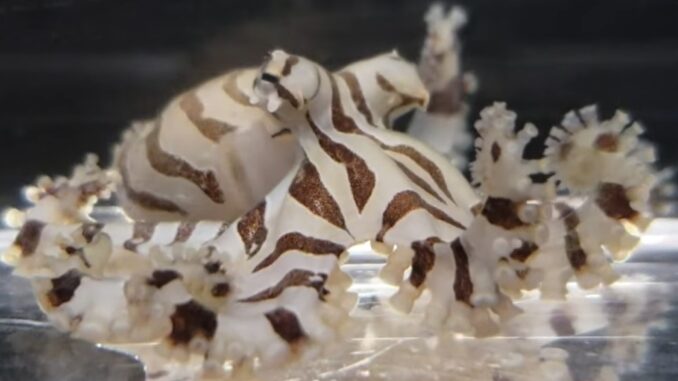
Octopus chierchiae, commonly known as the ‘lesser Pacific striped octopus’ or the ‘pygmy zebra octopus’ is one of the smallest species in the Octopodidae family. Comparable to a grain of rice when hatched, a newborn’s mantel measures about 3.5 mm (slightly more than an eighth of an inch) long. An adult male’s mantel length is approximately 20–30 mm (three-quarters to one-and-a-quarter inches), while the adult female is a bit larger still. (The mantel is the body of the octopus, excluding the eight tentacle arms.)
Not a great deal is known about the pygmy zebra octopus. Their small size makes them difficult to find and study in the wild, especially since they hide during daylight hours. We really don’t know the size of the wild population or whether it’s an endangered species or not. Its habitat lies along the Pacific coast of Central America, particularly around Nicaragua and Panama. Their lifespan is close to a year when in captivity, and somewhat less in the wild. Besides zebra stripes, an O. chierchiae can change it’s color to be a “creamy” all-white, or all brown, or even become translucent.
Most octopus species breed one time, and then quickly reach the end of their life spans, which makes studying them in the lab difficult. However, O. chierchiae breeds several times in its life, and incubation time for a clutch of fertilized eggs is highly predictable. Another desirable trait they posses is dimorphism, i.e., it’s easy to tell a male apart from a female at a glance. Also, their small size is an advantage when keeping large numbers in captivity.
Over the decades, a number of researchers have attempted to culture and raise octopuses in the lab for study without success – until now. Scientists at the Marine Biological Laboratory (MBL) have published a paper describing their successful culturing methods for the pygmy zebra octopus in the journal Frontiers in Marine Science.
With a successful captive breeding program established, scientists will be able to readily study O. chierchiae and learn much more about the pygmy zebra octopus, which in turn will aid us in gaining a better understanding of all octopus species.
Scientific Classification
Kingdom: Animalia
Phylum: Mollusca
Class: Cephalopoda
Order: Octopoda
Family: Octopodidae
Genus: Octopus
Species: O. chierchiae
Binomial name: Octopus chierchiae
(Jatta, 1889)
So little is known and documented about O. chierchiae, the only relevant video I could find is: “Pygmy Zebra Octopus at the Marine Biological Laboratory” (0:40)
